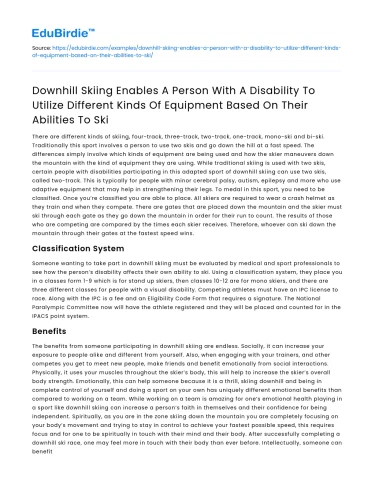There are different kinds of skiing, four-track, three-track, two-track, one-track, mono-ski and bi-ski. Traditionally this sport involves a person to use two skis and go down the hill at a fast speed. The differences simply involve which kinds of equipment are being used and how the skier maneuvers down the mountain with the kind of equipment they are using. While traditional skiing is used with two skis, certain people with disabilities participating in this adapted sport of downhill skiing can use two skis, called two-track. This is typically for people with minor cerebral palsy, autism, epilepsy and more who use adaptive equipment that may help in strengthening their legs. To medal in this sport, you need to be classified. Once you’re classified you are able to place. All skiers are required to wear a crash helmet as they train and when they compete. There are gates that are placed down the mountain and the skier must ski through each gate as they go down the mountain in order for their run to count. The results of those who are competing are compared by the times each skier receives. Therefore, whoever can ski down the mountain through their gates at the fastest speed wins.
Classification System
Someone wanting to take part in downhill skiing must be evaluated by medical and sport professionals to see how the person’s disability affects their own ability to ski. Using a classification system, they place you in a classes form 1-9 which is for stand up skiers, then classes 10-12 are for mono skiers, and there are three different classes for people with a visual disability. Competing athletes must have an IPC license to race. Along with the IPC is a fee and an Eligibility Code Form that requires a signature. The National Paralympic Committee now will have the athlete registered and they will be placed and counted for in the IPACS point system.
Save your time!
We can take care of your essay
- Proper editing and formatting
- Free revision, title page, and bibliography
- Flexible prices and money-back guarantee
Benefits
The benefits from someone participating in downhill skiing are endless. Socially, it can increase your exposure to people alike and different from yourself. Also, when engaging with your trainers, and other competes you get to meet new people, make friends and benefit emotionally from social interactions. Physically, it uses your muscles throughout the skier’s body, this will help to increase the skier’s overall body strength. Emotionally, this can help someone because it is a thrill, skiing downhill and being in complete control of yourself and doing a sport on your own has uniquely different emotional benefits than compared to working on a team. While working on a team is amazing for one’s emotional health playing in a sport like downhill skiing can increase a person’s faith in themselves and their confidence for being independent. Spiritually, as you are in the zone skiing down the mountain you are completely focusing on your body’s movement and trying to stay in control to achieve your fastest possible speed, this requires focus and for one to be spiritually in touch with their mind and their body. After successfully completing a downhill ski race, one may feel more in touch with their body than ever before. Intellectually, someone can benefit from this by learning new things about their control and ability to control their body during skiing downhill. You have to really comprehend the motor skills, and the logistics of how your body movements and ski equipment must be used together in order to stay up and ski down the mountain at your fastest speed.
Assistive Technology
Depending on the individual playing the sport, different assistive technology is used. The different kinds of things that are used are Mono-skis, Bi skis, Adaptive ski bike, outriggers, adaptive braces, sit ski simulator, turning pole, and ski-2 prosthetic ski poles. Not everyone uses all of this equipment, it depends on the individuals skiing abilities. Technology like these, allow players to play the game by enabling them to use either one ski, two skis, or a sitting ski to make it down the mountain.
The organization which oversees downhill skiing is called the NSAA, The National Ski Areas Association. The NSAA encourages that people use the proper equipment for safety, and how to be aware of themselves while skiing down the mountain and being aware of others. They also have a responsibility code that has seven different responsibilities all skiers should follow. There is competition for this sport, downhill skiing is included in the winter Paralympics. It is also competed in the FSI and in the winter Olympics.






 Stuck on your essay?
Stuck on your essay?

